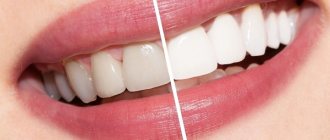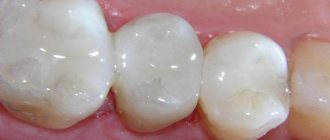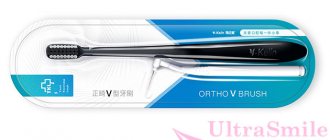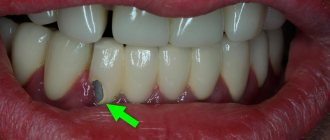In what cases is it necessary to install a filling?
The installation of restorative material is carried out not only in the treatment of carious lesions. The procedure is also performed when:
- presence of chips and cracks;
- elimination of consequences after mechanical damage;
- intense loss of hard tissues, leading to almost complete wear of the upper part of the teeth (for example, due to involuntary grinding of the jaws).
It is worth noting that any dental clinic performs filling only in cases where the destruction of the coronal part is insignificant. If the surface of the tooth is damaged by more than a third, it is replaced with an artificial substitute - a prosthesis.
The use of modern materials helps restore the beauty of the smile and chewing function, and also prevents further destruction of the mineralized coating.
Is a refilling necessary if nothing bothers me?
Many patients are surprised when a dentist recommends replacing an old filling with a new one, because they have no pain or other unpleasant symptoms. However, replacement is carried out not only in cases of severe inflammation, but also for preventive purposes, as well as to improve the aesthetics of the dentition.
Like any other material, the filling mass is subject to gradual wear, deformation, and destruction. Hygienic care, oral microorganisms, saliva pH, mechanical, chemical and temperature effects of food over time provoke the appearance of microscopic cracks in the filling. The resulting pores serve as a breeding ground for microbes and the development of dental diseases.
Good to know! After teeth whitening (especially when whitening by 8-15 shades), you will also need to start replacing old fillings, because they look darker than the new smile.
What types of fillings are there?
Depending on the period of use, temporary and permanent fillings are distinguished. The first ones are placed during treatment. For example, they cover a tooth for a while in order to understand whether the nerve is affected by caries or not. A temporary filling is also used to secure medications placed in a diseased tooth, or to secure arsenic after depulpation. After two weeks, temporary materials are replaced with permanent ones. The latter can last for years.
In modern dentistry, the following types of fillings are distinguished:
- Cement fillings are a budget option. They are difficult to grind, look unnatural and can cause destruction of the teeth they interact with.
- Metal (almagamic). They are made from an alloy of silver and copper, are characterized by increased strength, but also stand out against the background of the rest of the jaw. Often, fillings of this type are installed on teeth located further than the incisors.
- Composite fillings. They have a paste-like consistency and are applied in layers, so working with them does not cause much difficulty. Special ultraviolet light is used to fix composite materials. The variety of the palette allows you to choose a shade that will not differ from the native enamel, which is why composites are widely used for the restoration of anterior teeth.
- Ceramic fillings. In appearance and composition, they are as close as possible to the natural coating of teeth. Their production takes some time, so the fixation of the material is carried out in several stages. Ceramics are resistant to temperature changes. Its main advantage is also aesthetics.
Fillings made of chemically cured composite
They harden due to chemical reactions that occur during the interaction of the components of the filling. The filling contains an organic matrix and an inorganic filler. The paste and special catalysts are mixed before applying the paste and after a few minutes they harden into the desired shape. If necessary, the dentist polishes them, making them more comfortable and natural in shape for the patient. Complete curing occurs within a day. The composite material is durable and aesthetic, suitable for restoring anterior teeth.
Advantages of chemical composite fillings:
- Large color palette;
- High strength;
- Uniform curing regardless of filling size;
- Does not dissolve from saliva;
- Do not split or crack.
Disadvantages of chemical composite fillings:
- May shrink over time
What types of fillings are better?
Many dentists recommend installing fillings made of light-curing composite. They are characterized by increased strength and durability, and look natural. Composite fillings are suitable for filling cavities in distant teeth and restoring carious cavities, as well as for treating erosions of hard tissues. Their service life is 5 years.
Glass ionomer cement, which is a hybrid of acrylic and silicate components, is also considered a good choice for filling. Glass ionomer combines well with natural coatings and other established types of fillings; it is suitable for treating destructive processes of the tooth, filling the anatomical space under the roots, and preparing the cavity for further orthopedic manipulations.
How is the filling installed?
The fixing of the restoration material always follows the same pattern:
- First, the doctor injects into the tissues located around the damaged area.
- When the medicine begins to act, the specialist cleans the cavity from the remains of dead tissue, darkened mineralized parts and dentin, and gives it the desired shape and depth.
- The doctor then examines the pulp. If the connective tissue is not damaged, the prepared area is treated with an antiseptic. If the pulp is in a state of inflammation, then the dentist removes it from the tooth cavity and then fills the canals.
- After the above manipulations, the cavity is dried. Then special antimicrobial and insulating gaskets are placed in it.
- At the final stage, filling is carried out. At the end of the operation, the installed material is ground for comfortable closure of the jaws and polished.
After teeth filling
In some cases, after applying a filling, the sensitivity of the sealed tooth to external factors may increase: it may “ache” unpleasantly with any temperature change or when air enters. This most often happens when using composite materials. If the tooth remains sensitive two weeks after treatment, you should immediately consult a doctor.
A common cause of pain that occurs immediately after the anesthetic wears off can also be an excessive filling height. In this case, it should be reduced by the dentist.
The application of a filling is always accompanied by final grinding, during which the edges may remain sharp. Due to the action of the injection, this is often not felt immediately. If you notice protruding edges after the anesthetic has worn off, you should contact a dental clinic as soon as possible and make an appointment to straighten the tooth surface.
If the filling creates discomfort after treatment
Even in the dental office, after placing the filling, be sure to make sure that the restored tooth does not interfere, i.e. does not overestimate the bite (to do this, you need to create chewing movements of the lower jaw forward and backward, sideways, carefully close your teeth). The filling should not be felt or change the bite. There is no need to be embarrassed to talk about this discomfort to your doctor - sometimes the final stage of filling treatment can take even more time than preparing carious cavities and applying filling material, because The doctor’s main goal is to create multiple contact points between the filled tooth and the antagonist and in no case “turn off” the filling from the bite because this is fraught with changes in the temporomandibular joint.
After treatment, local anesthesia wears off within 1.5-2 hours. If a conductor type was used, then after 4-6 hours. Then you begin to fully feel the restored tooth, you can fully close your jaws and understand how comfortable you are after the treatment.
If you experience a little discomfort, you feel like the tooth is a little higher and your jaw isn't closing quite tightly - this is normal. The fact is that now you have been given a new filling in accordance with the bite, that is, with the shape and position of the antagonist tooth located on the opposite side. Therefore, if there is no sharp pain, be patient for a few days. If the situation normalizes and you get used to it, then there is no reason to see a doctor. If discomfort persists for 1-2 weeks, you should visit your dentist to have the filling corrected.
Rules for caring for fillings
Despite the fact that many fillings can theoretically last for years, it is recommended to change the materials every 10-12 years. It is recommended to visit a doctor once every six months for hygiene measures. You should also make an appointment with a doctor if:
- short-term pain in the treated area;
- detection of cracks;
- presence of a chip in the filling material.
The dentist can easily replace a bad filling with a new one.
If there is a large amount of restoration material in the cavity, you can ask the specialist to prescribe a gel with a high fluoride content. Its regular application will help strengthen the hard surface and prevent caries from forming again. Filled teeth may also be coated with fluoride varnish during the examination.
At home, it is recommended to use mouth rinses. With their help, you can significantly reduce the number of microbes that cause caries.
Summarizing the above, I would like to note that filling is a serious procedure. To prevent dental treatment under anesthesia from ending with repeated fillings and a double waste of time and money, you should seek help only from reliable, experienced specialists.
When is a refilling required?
To determine when a filling needs to be replaced, you should contact your dentist. He will conduct a diagnosis, including x-rays, and, if necessary, carry out a replacement.
Indications for refilling are the following conditions:
- pain in a filled tooth,
- crown destruction,
- detection of caries under filling material,
- feeling of an unpleasant taste,
- decreased aesthetics of the restoration,
- expiration of the seal's service life.
The most common situations in which refilling is required are discussed below.
Changing Hue
Yellowness, darkening and other color changes in the filling (and enamel) most often indicate the presence of a destructive process in the tooth. If there is a reddish tint, it means that the previously installed material contains resorcinol - in this case, not only a refilling is required, but also additional cleaning of the canals, as well as an internal bleaching procedure.
On a note! If the darkening is located on the border between the filling mass and the tooth tissue, this indicates a violation of the tightness. If timely refilling is not carried out, microbes will penetrate into the resulting space and caries will develop.
Abrasion of the filling mass
Over time, the fillings wear out, which leads to disruption of the distribution of chewing load. As a result, the bite changes, the load on the temporomandibular joint increases, TMJ pathologies develop, and digestive problems arise.
Overhanging filling
If installed incorrectly, the filling material may “hang” over the adjacent tooth or gum. The accumulation of food particles and impaired contact between units of the dentition provoke an inflammatory process in soft tissues, the proliferation of microorganisms and the development of caries, and bleeding gums.
Subsidence of the filling mass
Shrinkage is typical for any materials used for filling. If it occurs along the axis of the tooth, a person’s bite may change, which will lead to problems with the TMJ and digestion. In addition, vertical subsidence provokes the appearance of cracks and even chips in the tooth, since, as the filling contracts, it “pulls” the hard tissues along with it. When subsidence occurs in the horizontal plane, the degree of contact between adjacent units changes, food debris gets stuck in the interdental spaces, the formation of caries and gum inflammation are observed.
Flat filling surface
If, when filling, the dentist did not pay due attention to the chewing surface, but made it flat, disruption of the chewing process will gradually lead to the development of problems with the gastrointestinal tract. Normally, there are cusps and fissures on it, which ensures full contact with the opposite teeth of the other jaw.
Roughness has appeared
The rough surface of the filling indicates the presence of pores and microscopic cracks in it. This means that microbes have already penetrated into it. Often, when the filling material is removed in such cases, caries is revealed underneath it.
Expired service life
Even if the filling was installed more than 10-15 years ago and still holds, it does not mean that it is fulfilling its function. In the vast majority of cases, when refilling such “rarities”, an extensive carious process is determined.
Unaesthetic appearance
Refilling may be required if the previously installed filling stands out in shade from the background of the remaining teeth. Most often, the situation occurs after the whitening procedure. Over the period of operation, old compounds have absorbed various coloring substances, so to restore the aesthetic appearance (especially of the front units), they need to be replaced.











